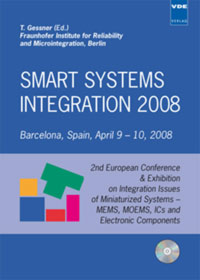A readout circuit for remote interrogation of capacitance transducers
Conference: Smart Systems Integration 2008 - 2nd European Conference & Exhibition on Integration Issues of Miniaturized Systems - MOMS, MOEMS, ICS and Electronic Components
04/09/2008 - 04/10/2008 at Barcelona, Spain
Proceedings: Smart Systems Integration 2008
Pages: 8Language: englishTyp: PDF
Personal VDE Members are entitled to a 10% discount on this title
Authors:
Nowak, Michel; Delorme, Nicolas; Colinet, Eric (CEA-LETI/MINATEC Grenoble, France)
Jacquemod, Gilles (LEAT, UMR CNRS-UNSA 6071, Nice Sophia-Antipolis, France)
Conseil, François (MBDA Le plessis-Robinson, France)
Abstract:
Continuous wireless data gathering systems have the potential to provide new insights in a variety of applications including security, health care, automotive and house automation. Looking at wireless sensing technology both active and passive telemetry are described in [1]. Active telemetry systems provide relatively long range bidirectional sensor data transfer, but with increased size and decreased lifetime due to their internal batteries. Passive telemetry systems significantly reduce transmission distances but allow the implementation of battery-free devices with indefinite lifetimes and maintenance-free operation. There are currently two methods for implementing passive telemetry systems. One method is established on radio frequency identification (RFID) devices principle. It uses micromachined sensors with built-in signal conditioning units and analog-to-digital converters. The whole system is monolithically integrated on a single chip with a dedicated telemetry circuitry which implements backscatter modulation to provide a reflected impedance change at the remote powering transceiver. Another approach is to use fully passive sensing devices allowing minimally invasive and low cost sensors since they can be fabricated using printed circuit technology. Low-power system design is essential when integrating sensors in passive telemetric apparatus in order to maximize the wireless range. Thus, capacitive embedded sensors are preferred over their piezoresistive counterparts since no power consumption is needed. These structures are LC-tank based sensors which are embedded or implanted in the system to be monitored. The resonant frequency of the embedded sensor changes in respect with the capacitance, resistance or inductance through the physical parameter of interest. Consequent changes in the resonant frequency are then wirelessly and remotely monitored through a wireless link. The LC sensor design depends on the environmental parameter to be measured, the value of the parameter to be measured, the range of values to be measured and sensitivity. Depending on whether the LC tank circuit is used to monitor pressure, strain, food quality, temperature or environmental gases, the sensor design is chosen. Then its behavior can be remotely figured out towards a frequency spectrum study. Although a lot of research effort has already been done in the development of suitable sensors, the main problem remains the wireless readout. Geometrical constraints required by the measurement setup, such as smallest and non invasive coils cause poor magnetic coupling between the sensor and the readout coil. A highly sensitive external readout circuit, e.g. an impedance analyzer, is thus required. This paper reports a novel readout system reliable and low-cost. It offers a platform allowing inductive telemetry of remote passive queried capacitive sensors. Suitable for continuous and real-time measurements of physical parameters, this architecture opens a wide range of instrumentation applications.


